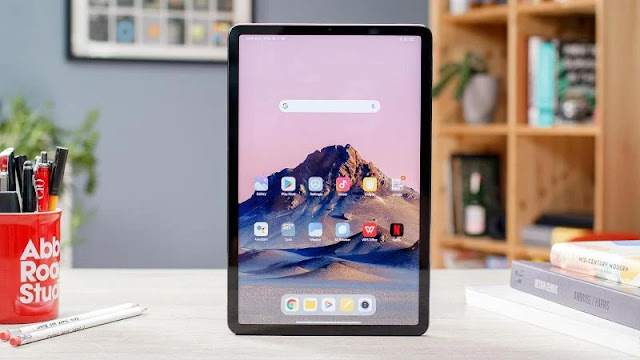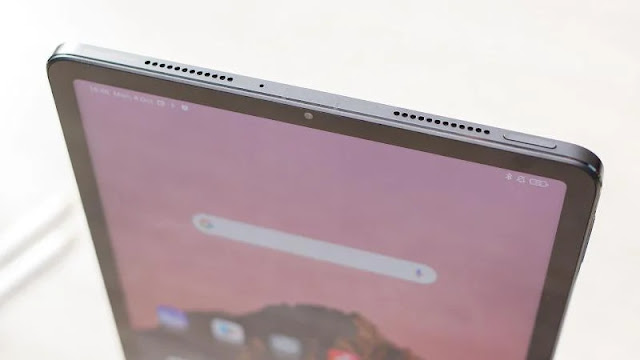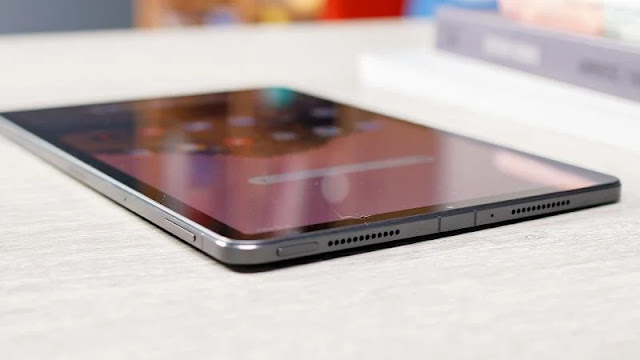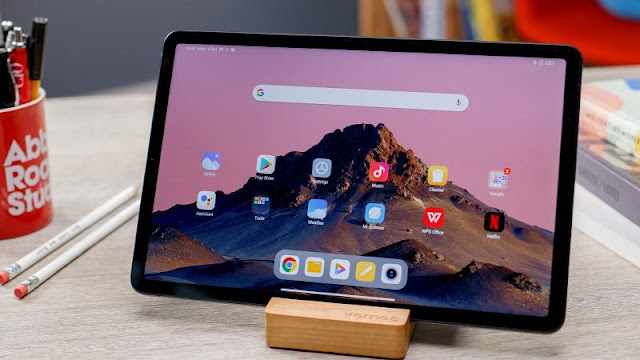The Xiaomi Pad 5 suffers from the software shortfalls of all Android tablets, but slick hardware and a great price point make this a true 10.2in iPad rival.
Should I Buy The Xiaomi Pad 5?
Pros
- Beautiful 120Hz, 2.5K display
- Strong specs
- Slim design
Cons
- Weak front-facing camera
- Android & MIUI under-optimised for tablets
- No LTE option
Our Verdict
- The Xiaomi Pad 5 is an exceptional Android tablet – but it is still an Android tablet.
- There’s little to fault on the hardware front, where you’ll find a lightweight design bolstered by strong specs, a gorgeous display, and great speakers. The software side is typical for an Android tablet, which is to say it’s fine, but can’t match an iPad, but this isn't enough reason to resist the Pad 5.
Price When Reviewed
- Unavailable in the US
Android tablets aren’t good.
Or at least, so the accepted wisdom goes. Sure, Samsung throws out a few Galaxy Tabs every year for the sake of it, and Amazon floods the cheap end of the market with budget-friendly Fire Tabs, but other than that the only tablets worth buying are Apple’s iPads.
For better or worse, Xiaomi clearly intends to change that. The Xiaomi Pad 5 is a committed effort to producing a quality mid-range Android tablet, priced as a direct competitor to the entry-level iPad.
As you might expect from Xiaomi, it out-specs its Apple equivalent in nearly every respect, while delivering the sort of slick design that Apple reserves for its premium models. Questions remain about how Android – and specifically MIUI – can compete with iPadOS, but with the tablet and foldable-focussed Android 12L on the horizon, with a bit of luck those will soon be concerns of the past.
Design And Build
- Slim and lightweight
- Premium look and feel
- No fingerprint sensor
I’ve already mentioned that the Pad 5 adopts the design language of the higher-end iPads – and I mean that quite literally. With squared off edges, a slim bezel, and premium materials this is plainly evocative of the iPad Pro aesthetic – and miles ahead of the dated design of the closest comparable iPad.
My review unit is in a colour Xiaomi calls ‘Cosmic Grey’, though depending on where you live it may also be available in white and green. While the Pad 5’s frame is aluminium, the rear is actually made of plastic. I’m sure some will lament the lack of a glass back, but plastic adds sturdiness to a device you’re potentially likely to use without a case, and Xiaomi has finished it here in a way that never feels cheap or, well, plasticky.
In terms of controls, you’ll only find a power button and volume rocker, placed on two sides of the same corner of the frame. Elsewhere there’s a USB-C port and a POGO connector for Xiaomi’s accompanying keyboard.
There is one frustrating omission from a hardware perspective: there’s no fingerprint sensor. There’s a small cylindrical marking on the right-hand side of the frame that looks like it’s meant to host a fingerprint reader, but it’s not there – and neither is one supported in the display. You can use face unlock, but that’s less secure and often less convenient, so it’s a shame not to see any fingerprint option available.
Display And Audio
- Great 11in, 2.5K 120Hz display
- Slim bezel
- Impressive quad speakers
The big draw of the screen here is that it boasts a 120Hz refresh rate – another premium touch that you’d not necessarily expect at this price.
This enables smoother animations and increased fluidity across the device – it’s a touch that’s now near-standard across Android phones, so there’s good odds you’ve tried it out by now. It will also unlock the potential for framerates above 60fps if you’re a keen gamer.
Whether you’re working, browsing the web, or streaming a few shows, this is a really enjoyable display to use, with punchy colours and great viewing angles. No, it’s not the absolute crème de la crème of tablet screens, but at this price it doesn’t need to be.
Xiaomi has arguably put even more effort into the audio. No, before you ask, there’s no 3.5mm audio jack – it’ll be wireless or USB-C headphones only I’m afraid – but the quad speakers here are really impressive.
Specs And Performance
- Flagship performance
- Only 6GB RAM
- No 4G or 5G option
Xiaomi has made smart choices in speccing the Pad 5 out, which effectively maximise performance without forcing it into a higher price point.
Key to that is the choice to use the Snapdragon 860, an over-clocked version of an older Qualcomm flagship chipset. Essentially it means you get enough power to make most everyday tasks a breeze and keep this capable of playing even demanding games at decent settings, but you’re not paying extra for the latest 5G connectivity or machine-learning upgrades and features optimised for the demanding cameras in flagship phones.
If there’s a compromise, it’s that the Pad 5 is only available with 6GB of RAM, where I would have loved to see 8GB available. In terms of storage, there are models with 128GB or 256GB, though availability does vary by region – and bear in mind that there’s no microSD card slot, so this is non-expandable.
In performance benchmarks the Pad 5 kept pace with last year’s premium flagship Galaxy Tab S7+, outpacing all the cheaper Galaxy Tabs and the recent Nokia T20 tablet. Admittedly it lags a little behind all the iPads on pure performance, but on the Android side at least this is one of the most powerful tablets around, especially given the price.
I did mention that one of Xiaomi’s cost-cutting measures is to skip 5G entirely. In fact there’s no 4G either, with the global version of the Pad 5 only available in a Wi-Fi model (China gets a 5G Pad 5 Pro model, but it’s not launching elsewhere), so do bear that in mind if you’re looking for an always-online device.
Perhaps disappointingly Wi-Fi 6 isn’t supported either, so you won’t get the absolute fastest speeds – but you’d need a pretty modern router to support that tech anyway. Elsewhere there’s Bluetooth 5.0, though understandably there’s no NFC, which is rarely used on tablets anyway.
Battery And Charging
- All-day battery life
- 33W charging – but ships with a 22.5W charger
- No wireless charging
Tablet battery life is tricky to assess, because use cases vary so dramatically. Some will need an all-day device for taking notes and working on, while others just want something to sit on the coffee table for checking your emails, or to spin up the odd Netflix episode.
I tend to fall into the latter camp, and with that in mind the Pad 5’s 8720mAh battery has impressed – I can leave it ready to use for days at a time without topping up, and I’ve never felt overly concerned about its longevity.
Our artificial battery benchmark reveals more. The Pad 5 lasts around ten and a half hours in the PCMark battery test – better than any Samsung Galaxy Tab we’ve tested in the last two years, and clearly enough to power a day’s work on the device.
Instead, Xiaomi ships the Pad 5 with a 22.5W charger, which is capable of topping the tablet up to 25% in 30min - good for a tablet, but not awe-inspiring.
If you have a faster charger around – or don’t mind buying one – you can hit faster speeds though. I managed a slightly more impressive 35% battery back in half an hour using the 55W Xiaomi charger that ships with the Mi 11, which should in theory have delivered power at around the 33W the tablet can handle.
Finally, it shouldn’t come as too much of a surprise that there’s no wireless charging support. Few tablets offer it, especially comparatively affordable ones, and it’s certainly a feature that’s less in demand for these larger devices.
Camera
- Disappointing 8Mp front-facing camera
- Decent rear camera
Cameras don’t really matter much on tablets. Or rather, rear cameras don’t matter much.
This is the one hardware area where Xiaomi has undoubtedly been bested by Apple’s entry-level iPad. This year Apple made the smart choice to load the better camera onto the iPad’s front, whereas Xiaomi has followed smartphone norms and prioritised the rear shooter.
The 8Mp, f/2.0 selfie camera here simply isn’t great, which is a shame. It’ll do the job for video calls – where it’ll likely see the most use of course – but image quality is still fairly soft thanks to the low resolution, and there’s a steep quality drop if you’re not well lit.
The 13Mp, f/2.0 rear camera is better – but you’ll probably barely use it. If you do find yourself needing to take photos with the tablet this can capture some surprisingly solid shots with vibrant colour and decent detail, even holding its own in lower light – though it’s not designed for true night photography. It can even shoot video in 4K at 30fps, if you find the need.
Software
From a hardware perspective, there’s really little to fault about the Xiaomi Pad, apart from the few small irritations I’ve mentioned above.
That’s not quite as true on the software side, though don’t take that to mean that the experience here is bad. It’s just still not up to Apple standard.
While Xiaomi has committed to three major Android version updates on some of its phones, there’s no such promise for the Pad 5 tablet as of yet. That means that we don’t know how many Android updates the tablet will get, or how many years of security software protection.
MIUI has received only small tweaks to fit the tablet form factor, and is otherwise mostly a familiar experience for anyone who’s used a Xiaomi phone. Concessions to the big screen are mostly cribbed from iPadOS: a two-column settings menu; control centre and notifications split between swipes down from the right and left sides of the screen respectively; an enlarged task switcher with split-screen options.
In general the UI has been stretched out to fit the larger tablet screen, but some elements still feel half-baked. The best example of this is the home screen, which has tons of dead space and only limited rows where you can actually place app icons or widgets. The result is that everything is spread out, whether you like it or not, and there’s actually not that much usable space.
There is at least some hope here, as at the time of writing Google is working on Android 12L, a variant of the OS optimised for the larger screens in foldable phones and tablets - with the Pad 5 tipped to be only the beginning of a new wave of Android tablet launches. This is currently set to launch in spring 2022, so hopefully later that year Xiaomi will push its own version to the Pad 5.
Features already confirmed for Android 12L include a revamped lock screen, columned notification and control centres, a Windows-style task bar, and revamped split-screen and multi-tasking functionality. It’ll be this that should the Xiaomi Pad 5 to the next level, with smooth software to match the slick hardware, but for the moment this feels a little under-optimised.
Price And Availability
The Xiaomi Pad 5 is available now in the UK, Europe, and much of Asia.
It costs £369/€399 for the 6GB+128GB model, though price will vary slightly by market - check out our guide to where to buy the Pad 5 for the best deals we've spotted.
The clear and direct competitor here is Apple’s 10.2in iPad, which costs £319/$329 – though that only gets you half the storage of the Pad 5, with 64GB.
You might also look at last year’s Galaxy Tab S6 Lite, for around the same price. This has the benefit of shipping with an included stylus, and offers an LTE option, but otherwise the Xiaomi Pad 5 beats it on just about every spec.
Check out our pick of the best tablets, and specifically the best Android tablets, for more options at different price points.
Verdict
The Xiaomi Pad 5 is an exceptional Android tablet – but it is still an Android tablet.
The software side is typical for an Android tablet, which is to say it’s fine, but can’t match an iPad. Despite Xiaomi’s best efforts, Android simply isn’t fully optimised for tablets, so you will run into occasional headaches as you navigate the Pad 5.
Still, the tablet runs smoothly even if it doesn’t fully make the most of the big screen, and with Android 12L’s improvements on the horizon this doesn’t feel like enough reason to resist the Pad 5.
Simply put, if you want to buy a tablet around this price and don’t mind stumping for Android, this is the one to buy.
Specs
- Qualcomm Snapdragon 870 chipset
- 6GB RAM
- 128/256GB storage
- 11in 120Hz 2.5K (256x1600) IPS LCD display
- Quad speakers
- 13Mp main camera, f/2.0
- 8Mp front camera, f/2.0
- USB-C
- WiFi 802.11 a/b/g/n/ac
- Bluetooth 5.0
- 8720mAh battery
- Wired charging up to 33W
- 511g
- 254.7 x 166.3 x 6.9mm
- Android 11 with MIUI 12.5




















0 comments:
Post a Comment